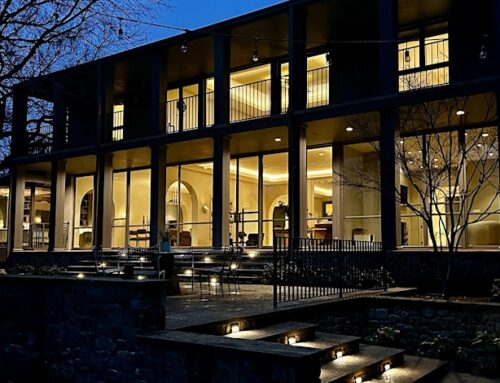The bronze plaques don’t tell all. Each one has the Texas Historical Marker insignia and a brief explanation of why the site deserves the heavy metal distinction.
But even if you look around our neighborhood to find the few places where history has been noted, you won’t learn the full story simply by reading the embossed wording.
The only way history comes to life is to hear it told from the mouths of people who know and love it most. To learn more about our past, we talked to the neighborhood people trying to record and preserve it for future generations.
The Cox Farmhouse
Howard J. Cox is a statuesque man, even at 83. He stands tall, his jaw line is strong, and he has a patrician poise about him.
“I am actually Howard Cox the third,” he says matter-of-factly. “My grandfather, the first Howard Cox, built a farmhouse in 1880, and my family lived in that house for three generations.”
That more-than-century-old farmhouse still stands in Preston Hollow. The two-story, shingled structure has narrow windows and a sharply pointed roof, making it reminiscent of a classic dollhouse. And although Cox no longer lives in it, he says that house will always be a part of him.
“For me, that home is alive with memories. I still remember the summer of 1934 there,” he says. His eyes glaze, and a gentle smile spreads across his face.
“My family ran a dairy farm on that land, and there was a huge pasture near Midway Road and Northwest Highway. My father told me he’d pay me to rake up all the hay out there. I was just 10 years old, but I rounded up a team of horses and worked all summer in that pasture.
“I remember I earned enough money to buy a train ticket to Houston to visit some relatives. I have grandchildren today, and I simply can’t imagine them working and traveling alone, the way I did when I was 10. But looking back, it was a different world way back then.”
In the 1930s, Cox says children took on adult roles much earlier, especially in the country. Cox lived and worked on his family’s dairy farm until 1944, when he enlisted to fight in World War II. The Cox family sold their dairy farmland in 1947, and in 1968 they sold the farmhouse.
“My father and uncle ran that dairy farm, and they were in their late 60s by then,” Cox says. “I was stationed in Germany when my dad wrote me and asked me if I’d like to take over the farm, but after remembering how much work it was, I told them to go ahead and sell it.”
The house went through two owners until Janis Baldwin bought it in 1994.
“I’ve always loved old homes, but in a neighborhood like Preston Hollow, you don’t find very many — and the ones on Swiss Avenue are much larger than anything I’d ever want,” she says.
“I was driving by when I spotted the Cox house, and it just happened to be for sale. I fell in love with this house, and 13 years later, here I am.”
In those 13 years, Baldwin has poured energy and money into refurbishing the house.
“We did some remodeling, and when we opened one of the walls, we found an old letter written by Mr. Cox,” she says. “He had written the letter to his sister, and he was telling her that he planned to take a covered wagon to Farmers Branch so he could sell his farm crops.
“He anticipated this trip would take him a full day. It’s just so cool to discover those little bits of life from the people who lived here before me. Like, for example, Mrs. Cox sold fresh farm eggs from her kitchen window. So whenever I’m in my kitchen, I’ll try and imagine what it was like when that was Mrs. Cox’s kitchen, and she was selling eggs there. Little things like that really make me love this house.”
Baldwin has embraced the Cox family history, researching it extensively — and in fact, she’s good friends with Cox today.
“He’s sort of adopted me and made me part of his family, and whenever his grandkids are in town, he’ll bring them to see the house, which I think is very neat,” she says.
“In a way, I really feel like the caretaker of this family’s history — and I feel like the caretaker of this house for our community, because the history here belongs to the entire community, not just the Cox family, and not just me.”
Cox says he couldn’t be happier to have Baldwin living in his family’s home today.
“It feels good to see someone taking care of the house, and enjoying the history that’s there,” he says.
1742 Cox Lane
Just up the street from the Cox house at the corner of Northaven Road and Cox Lane sits a boxy gray house.
Unlike the Cox house, there is nothing grandiose about this structure, and no historical marker sits in front of it. But the history of this home is still important, or at least Cox thinks so.
His two aunts bought this home in the early 1930s, so it was a regular hangout during his childhood.
“Our farm was really more of a family compound,” he says. “My aunt Francis and my aunt Elizabeth lived on our farmland in their own house. And because I was just down the road, I got to know my aunts very well, and they were great women. They made sure I had a proper upbringing.”
Cox’s aunts purchased the home from the State Fair of Texas and moved it onto the family’s farmland. Baldwin says eventually she’d also like to buy that house.
“This house is important because it’s part of the Cox family history as well, and it’s part of the Texas State Fair history,” she says.
“I’d like to buy it and get a historical marker for it. I have room for it on my land, so I’d like to put it in my back yard and restore it. I’d really like to save that house because the history of it is worth saving.”
Right now, a neighbor across the street owns the house, but Baldwin says as soon as the owner decides to put the house on the market, she’ll be first in line to buy it.
Elizabeth Cox was a prominent religious figure in Dallas. She graduated from the Scarritt Bible and Training School in Kansas City, Mo., and was consecrated as a Methodist deaconess. She served several missions in Misouri, Florida and Texas before returning to the Cox dairy farm in 1926.
Once she returned to Dallas, she became a deaconess at the Cochran Chapel Methodist Church, which was founded by their family friends, the Cochrans. She remained a deaconess there until she passed away in 1963 — and in 1974 the church built the Chapel of Silence, or the Cox Chapel, in her memory as a pioneer of the Dallas Methodist community.
Cochran Chapel Methodist Church & Cemetery
The Cochran Chapel Cemetery is an eerie, yet serene place. Brushy thickets blanket the weathered headstones, allowing only puddles of sunlight to seep through.
And even though the one-acre plot sits just off the busy intersection of Northwest Highway and Midway, there’s a hushed calm here. It’s easy to imagine that, somehow, this place has managed to remain untouched by the hands of time, and you get the feeling that this graveyard probably looks a lot like it did back in 1853, when the first Cochran was buried here.
“Nancy Jane Cochran’s infant daughter was the first to be buried here,” says Gail Madden, the great-great-granddaughter of Nancy Jane Cochran.
“She buried her baby daughter near her home, and 17 days later, her husband died of typhoid fever, and she also buried him here in this graveyard. She was left a widow with six children to care for. Nancy Jane Cochran was a real stalwart, one of the first real pioneer women of Dallas.”
Nancy Jane Cochran donated three acres of land for the Cochran Chapel United Methodist Church in 1856, making it the oldest deeded Method
ist church in Dallas. She reserved one of those acres as her family’s graveyard, and she lived in a farmhouse near the church with all her children.
That farmhouse is still standing on the church property, but during World War II, it was converted into a duplex. Today, the church’s superintendent lives on one side of the duplex, and occasional church meetings are held on the other side.
Madden says she feels fortunate to have such a well-preserved family history, and says each generation keeps the history alive by relaying tales about the Cochrans’ pioneer days. She recalls hearing many tales about her great-great-grandmother whenever she visited the Cochran Chapel Cemetery.
“When I was a child, my mother would bring me to this cemetery every summer to help her water because this place is so old, it doesn’t have an irrigation system,” she says.
“While we’d be working here in the cemetery, my mother would tell me stories about Nancy Jane Cochran. My favorite one was about how she’d send her boys to church every Sunday, and because she was a widow who worked around the clock, sometimes she couldn’t go with them.
“But to make sure they went to church, she’d sew threads around the buttons on their church coats. This way if they decided to skip church and go swimming in the creek instead, she’d be able to tell because the threads around their buttons would be broken. She was a very clever woman, and my mother loved to tell me about her.”
The Cochran Chapel Cemetery was also the site of several prayer meetings during the Civil War because during that time, civilians didn’t dare light up the church at night for fear it would attract passing soldiers.
“We actually had two uncles who fought in the Civil War: one for the South, and one for the North,” she says. “A handful of other Confederate Civil War soldiers are buried here, as well as those from more recent wars.”
The Cochran Chapel Cemetery is running out of space for graves today, and Madden says the family is considering clearing away some of the brush to make room for more gravesites.
“I remember asking my father before he passed away how family members arrange to be buried here at the Cochran Chapel Cemetery and he just laughed and said: ‘Honey, I think it’s on a first-come, first-serve basis,’” she says.
“I wish we had room to bury all the future generations here, but no matter what, this graveyard will always be a part of our family.”






